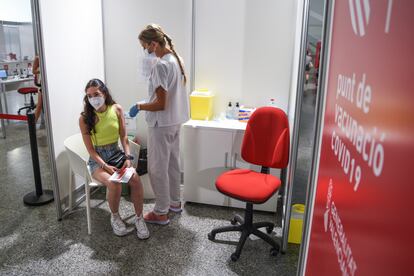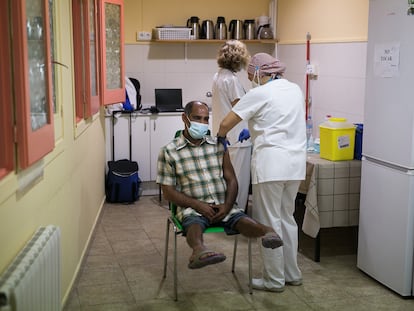Spain at risk of missing August vaccination target as rate of immunization drive slows
At the current pace – which has dropped by half – the Spanish government will not reach its goal of fully vaccinating 70% of the population until September

Spain is at the top of the list of countries that are vaccinating their populations against Covid-19 the fastest, but the rhythm of the process has slowed considerably over the last month. The campaign hit new heights in the second week of July, when more than half a million people were being immunized every day and 379,000 people were receiving their second shots. But since then, this latter figure has been steadily falling: 272,000 second doses administered every day by the end of July, 189,000 in the first half of August, and 172,000 in the last seven days. In just five weeks, the rate has fallen by 55%.
At the current rate, Spain will not reach its target of 70% of the population fully vaccinated until September. The prime minister, Pedro Sánchez of the Socialist Party (PSOE), had promised this milestone would be hit by the end of August. This percentage was thought to be needed for herd immunity to be achieved in Spain, but given the emergence of the more-contagious delta variant, it has become a more symbolic target. Experts consider that vaccine coverage of over 80% will be needed, and many doubt whether herd immunity can be achieved at all.
According to the latest Health Ministry figures, 29,794,008 people in Spain now have the full coverage offered by the vaccines being used (Pfizer-BioNTech, Moderna, Janssen and Oxford-AstraZeneca). This is 62.8% of the total population, and 70.7% of the 12-and-overs – i.e. citizens currently eligible for the Covid-19 vaccines. There are nearly 3.4 million people to go before Spain hits 33.2 citizens vaccinated, which is 70% of the country’s inhabitants. Looking at the rhythm of the first doses administered since mid-July – more than 1.3 million a week – and taking into account the gap between the two shots – 21 days for Pfizer and 28 for Moderna – August will end with a few more than 32 million people fully vaccinated, which is a million people short of the objective.
The head of preventive medicine at Barcelona’s Hospital Clínic, Antoni Trill, explains: “Given the circumstances, it would be very good news to reach 70% when the school term begins. We usually say that the last kilometers are the hardest, because it is easier and faster to vaccinate those who are already motivated. We started very well, but we are seeing a worrying slowdown in the rate of vaccination, especially among the under-50s.”
We can expect a return to a good speed once people return from their holidaysElena Vanessa Martínez, president of the Spanish Epidemiology Society
Summer vacations, the lower perception of risk from Covid-19 among younger age groups and the scale of the fifth wave – which means that those who have been recently infected with the coronavirus will have to wait several months before they can get their shots – are the reasons the experts and the administrations point to for this slowdown.
Given this situation, regions such as Catalonia and the Basque Country have decided to reduce the time between an infection and the administration of a vaccine from six to two months. Murcia has brought the time frame down even further, to four weeks, while Galicia, Madrid, Valencia and the Balearic Islands have confirmed to EL PAÍS that they are considering doing the same.
For Elena Vanessa Martínez, the president of the Spanish Epidemiology Society (SEE), the vacation season is to blame for this slowdown, given that Spanish citizens must get vaccinated in their own regions. “I don’t think it’s a problem of rejection, which is minimal,” she says. “We can expect a return to a good speed once people return from their holidays.”
The fall in the rhythm of the campaign has coincided with a rise in the availability of vaccine doses. This is in contrast to the situation seen at the outset of the summer, when there were more people awaiting vaccination than there were available doses. While in the middle of July the regions were taking specific measures to attract the unvaccinated – i.e. those who had not been immunized despite it being their turn – from August, they have been seeking out anyone who is eligible to be vaccinated.
While there are minor differences between regions, the common elements are that the campaign has now been opened to everyone aged 12 and over – none of the vaccines so far have been approved for younger ages. What’s more, the process has been opened up thanks to units that do not require prior appointments and have longer hours.
Elena Vanessa Martínez believes that “this is a good strategy, which also facilitates access to the vaccine for people who for personal, work or other reasons cannot always access the healthcare system under the conditions of a prior appointment.”
The lowest attendance for vaccinations is among the 20-30 age group, but we couldn’t call it rejection. They are not coming due to work reasons, travel, vacationsSpokesperson from the Castilla-La Mancha region
Scientific literature has traditionally differentiated between two profiles that are most difficult to vaccinate. The first are the anti-vaxxers. The majority position for this group is that it is not worth spending time trying to convince them, given that in Spain they are very few and cannot be convinced given that they do not respond to a rational approach. The second are the vaccine hesitant. Trilla explains that these are “people with doubts about the safety and the efficiency of the vaccines. They want more information and it is important to offer it to them because they usually respond well to specific explanations.”
The expert also draws attention to a third profile: the apathetic. “We are discovering this now,” he explains. “These are people who do not feel called upon, who aren’t very interested, who have other priorities… It’s not so much an issue of information but rather one of motivation. With these people, it would be convenient to seek figures with charisma and a reputation among different population groups in order to involve them in the campaign.”
There is hardly any information available about which collectives or population groups have the lowest vaccination rates. The data offered by some regions confirm that outright rejection of the vaccines in Spain is very low, at around 1%, and there are other reasons behind the current slowdown.
“The lowest attendance for vaccinations is among the 20-30 age group, but we couldn’t call it rejection,” explains a spokesperson from the Castilla-La Mancha region. “They are not coming due to work reasons, travel, vacations…” In the Basque Country, meanwhile, the segment presenting most difficulties is the 30-39 age group, according to sources from the regional health service. Other regions, such as Galicia, also point to the under-40s.
Latest figures
The Spanish Health Ministry on Monday reported 25,726 new coronavirus infections as well as 125 Covid-19 fatalities since Friday. The 14-day cumulative number of coronavirus cases per 100,000 inhabitants has fallen 46 points since the last report, and now stands at 416. In total, 4,719,266 coronavirus infections have been detected in Spain since the pandemic began, while the death toll stands at 82,595.
By region, the incidence is falling across all of Spain’s territories, apart from in the North African cities of Melilla and Ceuta, where it has risen by six points to 496 cases per 100,000 inhabitants in the former, and by 24 points to 483 cases in the latter. In Ceuta, 77 of the 229 cases detected in the last seven days are associated with outbreaks in migrant shelters, the local authorities report.
The recent fifth wave of the coronavirus was mostly among younger, unvaccinated people. According to Monday’s report, the infection rate for the 20- to 29-year-old age group is still falling, moving from 911 cases on Friday to 804 yesterday. For the 12- to 19-year-old group meanwhile, the incidence rate over 14 days has also fallen, coming in at 876 infections per 100,000 inhabitants according to yesterday’s report.
With reporting by Bernat Coll, Pedro Gorospe, Eva Saiz, Cristina Vázquez and Sonia Vizoso.
English version by Simon Hunter.
Tu suscripción se está usando en otro dispositivo
¿Quieres añadir otro usuario a tu suscripción?
Si continúas leyendo en este dispositivo, no se podrá leer en el otro.
FlechaTu suscripción se está usando en otro dispositivo y solo puedes acceder a EL PAÍS desde un dispositivo a la vez.
Si quieres compartir tu cuenta, cambia tu suscripción a la modalidad Premium, así podrás añadir otro usuario. Cada uno accederá con su propia cuenta de email, lo que os permitirá personalizar vuestra experiencia en EL PAÍS.
¿Tienes una suscripción de empresa? Accede aquí para contratar más cuentas.
En el caso de no saber quién está usando tu cuenta, te recomendamos cambiar tu contraseña aquí.
Si decides continuar compartiendo tu cuenta, este mensaje se mostrará en tu dispositivo y en el de la otra persona que está usando tu cuenta de forma indefinida, afectando a tu experiencia de lectura. Puedes consultar aquí los términos y condiciones de la suscripción digital.
More information
Últimas noticias
Most viewed
- Reinhard Genzel, Nobel laureate in physics: ‘One-minute videos will never give you the truth’
- Oona Chaplin: ‘I told James Cameron that I was living in a treehouse and starting a permaculture project with a friend’
- Pablo Escobar’s hippos: A serious environmental problem, 40 years on
- Charles Dubouloz, mountaineering star, retires at 36 with a farewell tour inspired by Walter Bonatti
- Why we lost the habit of sleeping in two segments and how that changed our sense of time










































